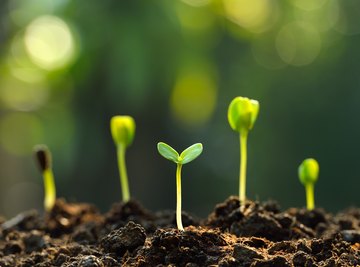
Flowering plants, or angiosperms, fall into two classes, based on the number of cotyledons, or seed leaves, within their seeds. For monocotyledons, also called monocots, seeds contain only one cotyledon. In contrast, dicotyledons or dicots hold two cotyledons in their seeds. These cotyledons are the first leaves of a seedling and serve to absorb nutrients in the endosperm, or food storage of the seed. They are not used for photosynthesis.
TL;DR (Too Long; Didn't Read)
Monocot seeds contain one cotyledon, or seed leaf, whereas dicot seeds contain two cotyledons. While initial seed germination processes are similar in both monocots and dicots, there are some fundamental differences.
Differences Between Monocots and Dicots
Monocots and dicots differ morphologically. Monocot pollen possesses a single furrow in its outer layer, parts such as stamens and petals are in multiples of three, leaf veins are parallel, the vascular strands are scattered in the stem, roots are adventitious (arise from the plant stem) and there is no secondary growth such as wood or bark. Monocot examples include onions and grasses.
A dicot’s two cotyledons serve as nutrient storage and occupy a large amount of the seed’s volume. Dicot pollen has three furrows, flower parts are in multiples of four or five, leaf veins are branched, vascular bundles are situated in a cylinder in their stems, roots form from a radicle and taproot system, and they usually exhibit secondary growth. Dicot examples include legumes and hardwood trees.
Seed Germination Requirements
Both monocot and dicot seeds require similar conditions for seed germination. Their seeds must be fully developed, with an embryo, endosperm, appropriate number of cotyledons and a coating (testa). The cotyledons and endosperm will support the growing plant as a food source until photosynthesis begins. Seed germination requires optimal environmental conditions to germinate. Temperatures must be warm enough so seeds can germinate, but not so hot as to damage the seed. Temperatures cannot cold enough to damage or initiate dormancy in the seed. Moisture in the soil contributes to a seed’s germination, as does a need for oxygen and carbon dioxide. Different species require different light conditions to aid germination until seedlings are exposed to necessary sunlight.
Steps of Germination in Monocots and Dicots
Seed germination begins with a seed absorbing water, which leads to swelling and a softening of a seed’s coat or testa. The water initiates biochemical activity in the seed. Monocots have starchy seeds and need about 30 percent moisture content to germinate. Dicots have oily seeds and will begin germination after reaching at least 50 percent of moisture content. After this, a lag phase gives the chance for a seed to begin internal processes such as cell respiration, protein synthesis and metabolism of food stores. After this, cell division and elongation occur, pushing out the seed’s root and radicle.
In monocots, the root that emerges is covered by a coleorhiza, or sheath. Its seedlings’ leaves then come forth, sheathed in a layer known as a coleoptile. In dicots, a primary root emerges from the seed. This is a radicle, and this root allows water absorption by the new plant. An apical meristem will eventually develop from this radicle and produce the plant’s root system. Then its shoot comes forth from the seed, consisting of the cotyledons, hypocotyl and epicotyl.
Dicots can have one of two types of germination, depending on their species: epigeous germination or hypogeous germination. In epigeous germination, the shoot can make a hook and pull the cotyledons and tip through the soil and into the air above the surface. In hypogeous germination, cotyledons remain underground and eventually decompose, while the section above them continues growing.
In both monocots and dicots, seedlings grow slowly after they emerge above the soil. The seedling first develops its roots and then its true leaves that can photosynthesize and convert sunlight to energy for the plant.
References
- University of California Museum of Paleontology: Monocots: More on Morphology
- University of California Museum of Paleontology: Monocots Versus Dicots: The Two Classes of Flowering Plants
- Frontiers in Plant Science: Cell Cycle Control and Seed Development
- Pennsylvania State University Extension: Seed and Seedling Biology
- USDA Natural Resources Conservation Service: Dicot or Monocot? How to Tell the Difference
About the Author
J. Dianne Dotson is a science writer with a degree in zoology/ecology and evolutionary biology. She spent nine years working in laboratory and clinical research. A lifelong writer, Dianne is also a content manager and science fiction and fantasy novelist. Dianne features science as well as writing topics on her website, jdiannedotson.com.
